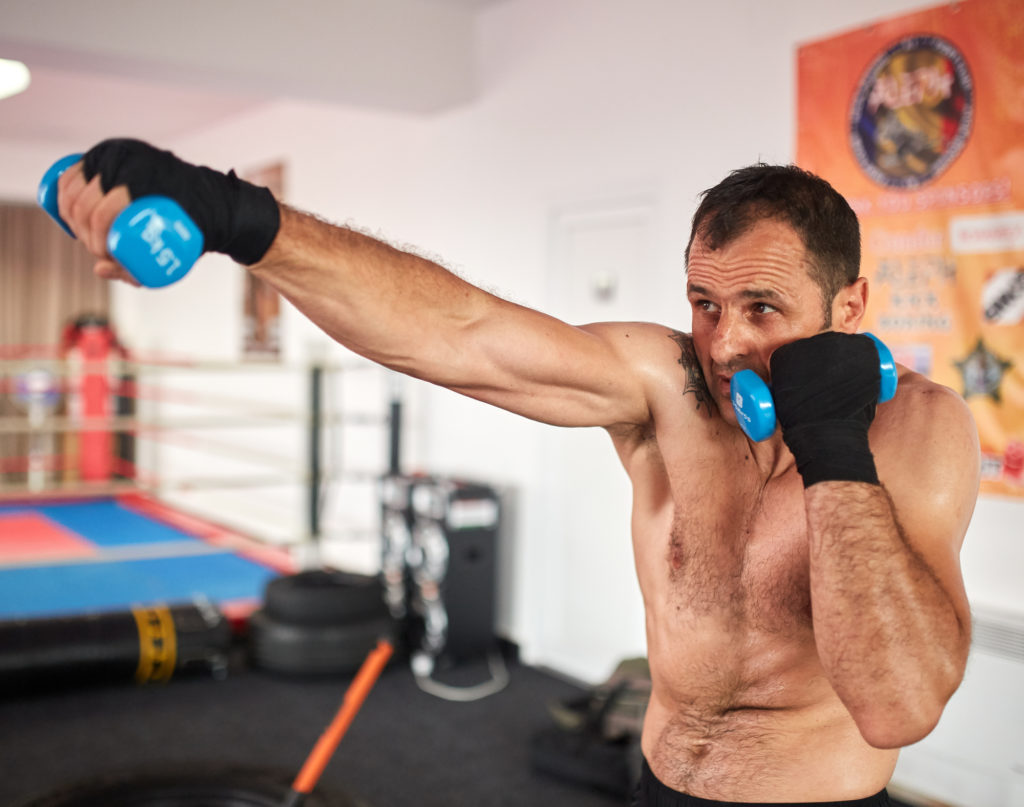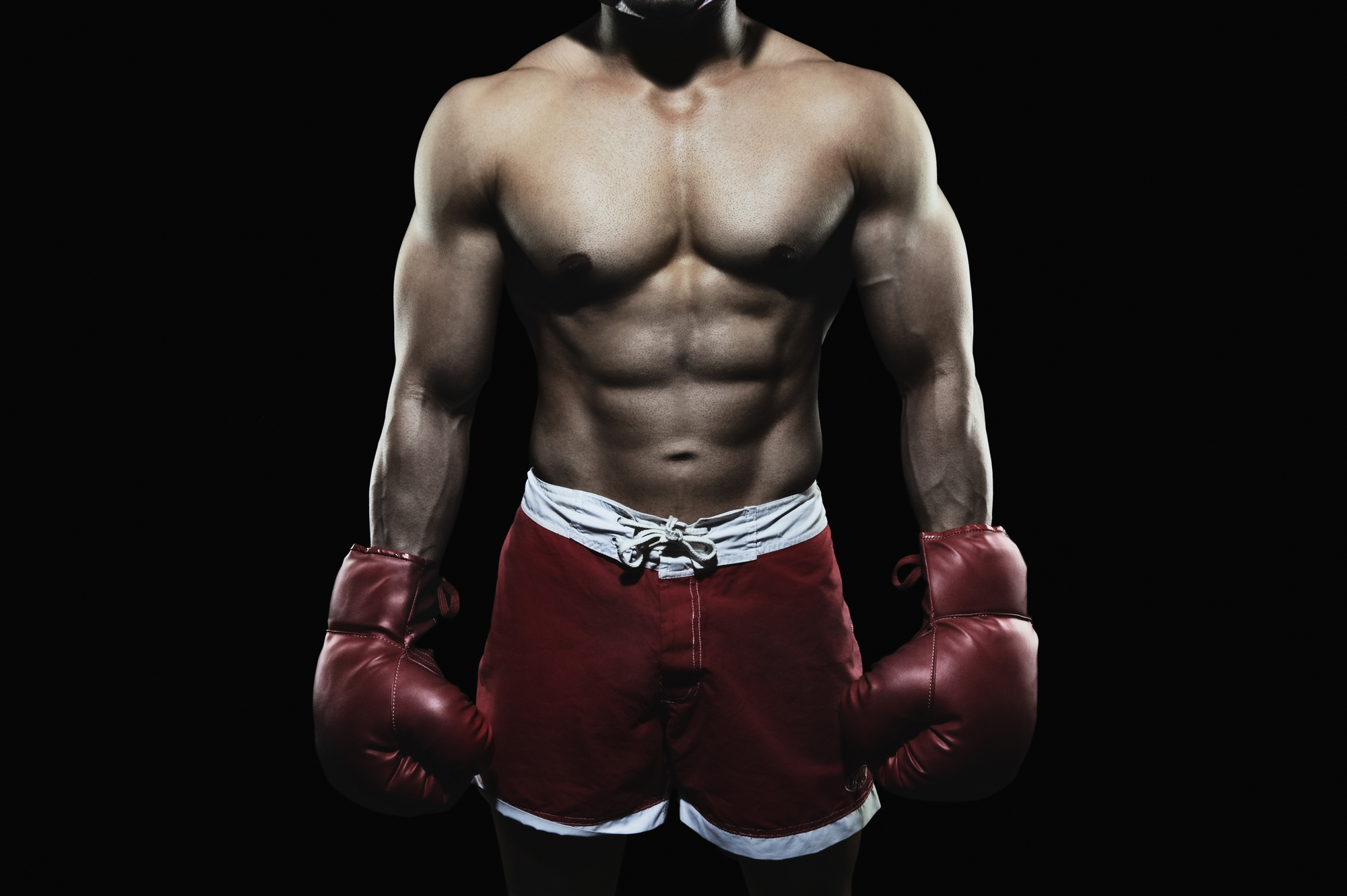Muay thai strength training is one area in which Western and non-Thai experts can be seen as having an advantage over traditional Thai boxing trainers and gyms.
Sports science from the West as well as Eastern European experts have made major advances in knowledge of how to increase the strength and conditioning of athletes.
Furthermore, studies have shown that dedicated strength training sessions coupled with regular muay thai training can increase athletic performance.
In this post we will define what strength training is and discuss the goals of strength training in terms of increasing maximal strength.
We also look at traditional strength training in muay thai gyms as well as the benefits of dedicated muay thai strength training for a fighter.
If you are interested also in developing cardio conditioning for muay thai you can check out a separate post I wrote specifically for developing your cardio.
What is Strength Training?
Strength is “the ability to produce force against an external resistance”.
The strength of an athlete is their ability to produce force.
Strength training are the methods of increasing strength. These methods and exercises must include resistance training.
Resistance training commonly uses weights but can also include bodyweight exercises and resistance bands.
Any exercise that requires force production and stimulates the body’s nervous system to produce muscular force can be considered strength training.

Then doesn’t punching and kicking the pads or a heavy bag also qualify as strength training?
Technically, yes.
But the maximal strength of an athlete is not nearly as much tested or reached when compared to traditional resistance training methods, especially using weights.
Maximal Strength Training
Maximal strength is the ability to exert force upon an external object, typically measured by a 1 rep max on a barbell based exercise such as a squat or press.
Thus maximal strength training requires heavy stimulation of the nervous system to exert a great amount of force in one movement i.e bench press, squat, dead lift.
These movements and expressions of maximal strength are rarely ever used in most Thai boxing gyms.

Therefore it is possible that quite a lot of strnegth gains are “left on the table” in order to maximize time and recovery for typical muay thai sessions.
In other words, skill, speed, endurance and technical ability are more focussed on over muay thai strength training.
Strength Training versus Technical skill
Training for strength and flexibility is a must. You must use it to support your techniques. Techniques alone are no good if you don’t support them with strength and flexibility”
-Bruce Lee
The pursuit of strength in martial arts has long been seen as a “trade-off” between technical skill and strength development.
Bruce Lee was one of the pioneers in martial arts strength training and saw that strength training could be used to enhance technical skill.

Bruce Lee saw strength training as an integral part of martial arts training and he dedicated much of his time into researching, testing out and developing strength training exercises and programs for himself.
However up until today most traditional martial arts still see strength training and technical skill as “trade-offs”.
Muay thai is no different and in most traditional Thai boxing gyms in Thailand and around the world, dedicated strength training is often overlooked or neglected.
Common Muay Thai Strength Training Aspects
Most muay thai gyms have taken the path of prioritizing technical skill over strength development in most gyms in Thailand.
With Thai boxers training up to hours, twice a day for 6 days a week, dedicated strength training sessions are very tough to squeeze in.
In traditional muay thai gyms most strength sessions are packed in at the end of training with the most common exercises being body weight exercises of:
- pushups
- situps
- pullups
- squats
- burpees
These are often done in high repititions.
Weighted exerscises also included in traditional muay thai training include:
- neck strengthening (lifting up small buckets of cement while gripping through rope with their teeth)
- shadow boxing holding weights

And to be honest, these forms of strength training are adequate for the needs of most Thai boxers.
However as discussed above, there are possibly great strength gains that are left on the table due to neglecting dedicated muay thai strength training.
Strength Requirements for Muay Thai
Unlike more grappling focussed arts such as MMA, Wrestling, Judo and BJJ, maximal strength needs are not as essential in muay thai.
More similar to Western boxing, muay thai has less need for maximum deadlifts, squats and bench presses.
Western boxers and Thai boxers would rather forgo the extra muscle mass and strength in order to be more quicker, agile and lighter for their chosen weight class.

The kind of strength that is focused on for muay thai is explosive strength over repeated bouts of exertion.
The ability to be explosive in striking from Round 1 to Round 5 of a muay thai fight is one of the most important aspects of muay thai.
Clinching also is a major aspect of muay thai and also the time to show your muscular strength over your opponent in order to dominate and grind down your opponent.
Clinching in muay thai is one area where training to increase maximal strength would be beneficial.
Benefits of Dedicated Muay Thai Strength Training
The vast majority of scientific literature supports the use of S&C training as a means to enhance athletic performance. Programs can be manipulated to increase both strength and power and neither need be at the expense of an increase in body mass or a loss of flexibility.
Strength and Conditioning Journal, December 2009
The quote above taken from research conducted in 2009 and published in the Strength & Conditioning Journal, supports the idea that the inclusion of S&C with regular muay thai training enhanced athletic performance.
So it can be assumed that dedicated strength training sessions along with regular muay thai sessions can enhance athletic performance of the Thai boxer.
Being more powerful and stronger will help the Thai boxer to:
- strike harder and cause more damage to an opponent
- allow for more domination in the clinch through controlling the opponent
- be stronger in all the muscles of the body to better absorb blows
- more ‘relative strength’ than your opponent who is the same weight as you
- prevent injuries through stronger tendons and joints
The above study from the Strength & Conditioning Journal suggested 2 strength sessions per week with focus on increasing strength without increases in muscle cross-sectional area or muscle size.
Muay Thai Strength Training Recommendations
Having spent a lot of time researching and trying out different strength training programs for MMA, muay thai and boxing, here are some recommendations for muay thai strength training programs.
1. Be sure to test and assess
Before starting out make sure to test and record your major strength movements in order to monitor your progress.
Testing your 1RM or one rep max may not be the safest method unless you have a qualified coach and training partner. But it is useful to know.
You can also test your MAX pull ups as well as 5 rep max lifts on bench press, squats and deadlifts in order to work toward improving on those numbers in the long term.
2. Muay thai technical skill and strategy are your priorities
Be sure to keep your muay thai technical skill as the top priority to keep improving and working on.
The suggested 2 day a week strength training session from the 2009 Strength & Conditioning Journal article is a format supported by many strength coaches working with fighters.
If you are already getting in 12 muay thai sessions per week (like pro fighters in Thailand) then getting in an extra 2 sessions per week for strength training will already be tough.
But these two focused sessions per week can go a long way toward increasing your strength to improve as a muay thai athlete.
3. Follow a periodized program
With limited time available to us all and o for fighters especially training for an upcoming fight, its important to periodize your strength training into different phases.
Rather than lifting heavy weights every single session you should be looking to build all elements of your strength which include:
- Base strength
- Power
- Muscular endurance
#1 Highly Recommended Muay Thai Strength Training Resource
As you can see from this post, muay thai strength training is not as simple as thought and there are different elements of strnegth that need to be developed.
Phasing your strength training or using periodization is crucial especially if you are fighting and training hard.
Also through scientific studies it is shown that dedicated strength training can improve your athletic performance for muay thai without having to add muscular size or weight.
That being said, strength training for muay thai is more complex than throwing ogether some traditional bodybuilding and powerlifting routines.
Having an expert put togehter a specific program for you to help improve your martial arts or muay thai is highly reocmmended.
I would definitely suggest you check out Don Heatrick from heatrick.com as a notable muay thai specific S&C trainer, Heatrick has produced amazing resources to help the muay thai athlete improve their performance in the ring.
Resources:
1. “Strength and Conditioning for Muay Thai Athletes”; Strength and Conditioning Journal: December 2009 – Volume 31 – Issue 6 – p 78-92
2. “What is Strength Training? A Beginners Guide”; https://exerciseright.com.au/strength-training-beginners-guide/



